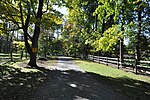Eustis Estate
Historic New EnglandHistoric districts in Norfolk County, MassachusettsHistoric districts on the National Register of Historic Places in MassachusettsHistoric house museums in MassachusettsHouses completed in 1878 ... and 5 more
Milton, MassachusettsNRHP infobox with nocatNational Register of Historic Places in Milton, MassachusettsQueen Anne architecture in MassachusettsUse mdy dates from August 2018

The Eustis Estate is a historic family estate on Canton Avenue in Milton, Massachusetts. Its centerpiece is the mansion house of William Ellery Channing Eustis, an eclectic Late Victorian stone building designed by preeminent architect William Ralph Emerson and constructed in 1878. The estate also includes several other houses associated with the Eustis family, and a gatehouse and stable historically associated with the main estate. The estate was listed on the National Register of Historic Places as a historic district in 2016. Most of the original estate is owned by Historic New England, and was opened to the public as a museum property in 2017.
Excerpt from the Wikipedia article Eustis Estate (License: CC BY-SA 3.0, Authors, Images).Eustis Estate
Canton Avenue,
Geographical coordinates (GPS) Address External links Nearby Places Show on map
Geographical coordinates (GPS)
| Latitude | Longitude |
|---|---|
| N 42.231666666667 ° | E -71.1075 ° |
Address
Eustis Estate Museum and Study Center
Canton Avenue
01286
Massachusetts, United States
Open on Google Maps










